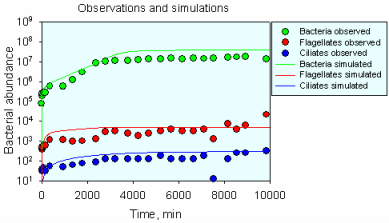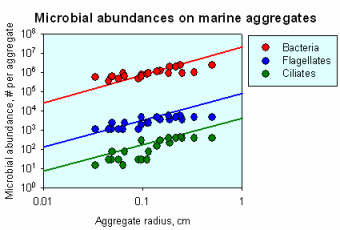Suspended particles and marine snow aggregates are microbial hot spots. Complex microbial communities develop on the surfaces of particles.
|
Bacteria
Bacteria abound on the surface of an aggregate.
Photo: H.-P. Grossart.
|

|
|
Flagellates
Many flagellates attach to particles and either feed on suspended bacteria or – as Bodo disignis – on bacteria attached to the surface of the particle. The flaggelates can be seen as small brown dots on the surface of a particle.
|
|
|
Microbes in the vicinity of particles
Microbes (here bacteria) also swarm in the vicinity of suspended particles. They can stay in the chemosphere surrounding the particle because of their chemokinetic behaviour (ability to swim up concentration gradients).
|
|
Microbes colonize particles
|
A sinking particle may scavenge bacteria and other microbes as it sinks. However, this is a very inefficient process because the sinking particle pushes the water away, thus preventing interception with small, suspended non-motile particles. On the video, flow is past the large sphere, which is equivalent to the sphere sinking. The smaller particles rarely intercept the larger one.
|
|
|
Swimming microorganisms collide with particles
Microbial colonization of particle happens mainly because micro-organisms swim. Most pelagic bacteria are motile, as are most flagellates and ciliates, some of which also colonize particles. Pelagic bacteria (video) may swim at very high velocities, corresponding to more than 100 cell lengths per second. Most swim in a "run-tumble" manner, in which they abruptly change direction (tumble) every few seconds. When colliding with a particle, they may attach. This is the main mechanism of colonization (Kiørboe et al. 2002).
|
|
Dynamics of attached microbial communities
|
Flagellates eat bacteria
Attached bacteria may be eaten by attached flagellates. The flagellate Bodo disignis (ca. 6 µm) attaches with one flagellum and uses the other to collect attached bacteria (Kiørboe et al. 2004).
|
|
|
Models to predict dynamics in microbial communities
The dynamics of microbes on an artificial particle suspended in seawater. The observed dynamics can be predicted from observations of colonization, growth, and grazing rates of bacteria, flagellates and ciliates using simple population models (Kiørboe et al. 2003).
|
 |
|
Models to predict abundance of microbes
Models may similarly predict abundances of microbes attached to field-collected marine snow aggregates. Here aggregates collected in the Øresund, Denmark. The full lines are predictions, not regressions (Kiørboe 2003).
|
 |
Back to list of research areas